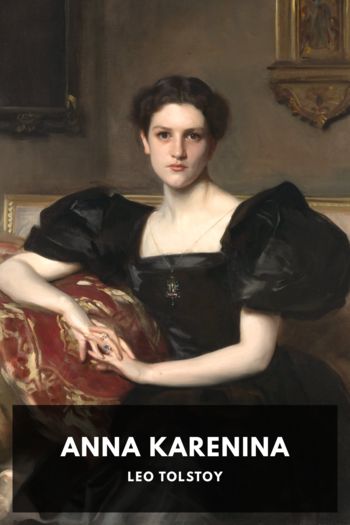What Is Art? Leo Tolstoy (good books to read for 12 year olds TXT) 📖

- Author: Leo Tolstoy
Book online «What Is Art? Leo Tolstoy (good books to read for 12 year olds TXT) 📖». Author Leo Tolstoy
Schasler, pp. 388–390. ↩
Knight, Philosophy of the Beautiful, i. pp. 165, 166. ↩
Schasler, p. 289. Knight, pp. 168, 169. ↩
R. Kralik, Weltschönheit, Versuch einer allgemeinen Aesthetik, pp. 304–306. ↩
Knight, p. 101. ↩
Schasler, p. 316. ↩
Knight, pp. 102–104. ↩
R. Kralik, p. 124. ↩
Spaletti, Schasler, p. 328. ↩
Schasler, pp. 331–333. ↩
Schasler, pp. 525–528. ↩
Knight, pp. 61–63. ↩
Schasler, pp. 740–743. ↩
Schasler, pp. 769–771. ↩
Schasler, pp. 786, 787. ↩
Kralik, p. 148. ↩
Kralik, p. 820. ↩
Schasler, pp. 828, 829, 834–841. ↩
Schasler, p. 891. ↩
Schasler, p. 917. ↩
Schasler, pp. 946, 1085, 984, 985, 990. ↩
Schasler, pp. 966, 655, 956. ↩
Schasler, p. 1017. ↩
Schasler, pp. 1065, 1066. ↩
Schasler, pp. 1097–1100. ↩
Schasler, pp. 1124, 1107. ↩
Knight, pp. 81, 82. ↩
Knight, p. 83. ↩
Schasler, p. 1121. ↩
Knight, pp. 85, 86. ↩
Knight, p. 88. ↩
Knight, p. 88. ↩
Knight, p. 112. ↩
Knight, p. 116. ↩
Knight, pp. 118, 119. ↩
Knight, pp. 123, 124. ↩
La philosophie en France, p. 232. ↩
Du fondement de l’induction. ↩
Philosophie de l’art, vol. i. 1893, p. 47. ↩
Knight, p. 139–141. ↩
Knight, pp. 134. ↩
L’esthétique, p. 106. ↩
Knight, p. 238. ↩
Knight, pp. 239, 240. ↩
Knight, pp. 240–243. ↩
Knight, pp. 250–252. ↩
Knight, pp. 258, 259. ↩
Knight, p. 243. ↩
“The foundling of Nuremberg,” found in the marketplace of that town on 26th May 1828, apparently some sixteen years old. He spoke little, and was almost totally ignorant even of common objects. He subsequently explained that he had been brought up in confinement underground, and visited by only one man, whom he saw but seldom. —Trans. ↩
Eastern sects well known in early Church history, who rejected the Church’s rendering of Christ’s teaching and were cruelly persecuted. —Trans. ↩
Keltchitsky, a Bohemian of the fifteenth century, was the author of a remarkable book, The Net of Faith, directed against Church and State. It is mentioned in Tolstoy’s The Kingdom of God Is Within You. —Trans. ↩
Anyone examining closely may see that the theory of beauty and that of art are quite separated in Aristotle as they are in Plato and in all their successors. ↩
Die Lücke von fünf Jahrhunderten, welche zwischen den Kunstphilosophischen Betrachtungen des Plato und Aristoteles und die des Plotins fällt, kann zwar auffällig erscheinen; dennoch kann man eigentlich nicht sagen, dass in dieser Zwischenzeit überhaupt von ästhetischen Dingen nicht die Rede gewesen; oder dass gar ein völliger Mangel an Zusammenhang zwischen den Kunst-anscliauungen des letztgenannten Philosophen und denen der ersteren existire. Freilich wurde die von Aristoteles begründete Wissenschaft in Nichts dadurch gefördert; immerhin aber zeigt sich in jener Zwischenzeit noch ein gewisses Interesse für ästhetische Fragen. Nach Plotin aber, die wenigen, ihm in der Zeit nahestehenden Philosophen, wie Longin, Augustin, u. s. f. kommen, wie wir gesehen, kaum in Betracht und schliessen sich übrigens in ihrer Anschauungsweise an ihn an—vergehen nicht fünf, sondern fünfzehn Jahrhunderte, in denen von irgend einer wissenschaftlichen Interesse für die Welt des Schönen und der Kunst nichts zu spüren ist.
Diese anderthalbtausend Jahre, innerhalb deren der Weltgeist durch die mannigfachsten Kämpfe hindurch zu einer völlig neuen Gestaltung des Lebens sich durcharbeitete, sind für die Aesthetik, hinsichtlich des weiteren Ausbaus dieser Wissenschaft verloren. —Max Schasler ↩
The contrast made is between the classes and the masses: between those who do not and those who do earn their bread by productive manual labour; the middle classes being taken as an offshoot of the upper classes. —Trans. ↩
Duelling is still customary among the higher circles in Russia, as in other Continental countries. —Trans. ↩
It is the weariness of life, contempt for the present epoch, regret for another age seen through the illusion of art, a taste for paradox, a desire to be singular, a sentimental aspiration after simplicity, an infantine adoration of the marvellous, a sickly tendency towards reverie, a shattered condition of nerves, and, above all, the exasperated demand of sensuality. ↩
Music, music before all things
The eccentric still prefer,
Vague in air, and nothing weighty,
Soluble. Yet do not err,
Choosing words; still do it lightly,
Do it too with some contempt;
Dearest is the song that’s tipsy,
Clearness, dimness not exempt.
⋮
Music always, now and ever
Be thy verse the thing that flies
From a soul that’s gone, escaping,
Gone to other loves and skies.
Gone to other loves and regions,
Following fortunes that allure,
Mint and thyme and morning crispness …
All the rest’s mere literature.
↩
I think there should be nothing but allusions. The contemplation of objects, the flying image of reveries evoked by them, are the song. The Parnassiens state the thing completely, and show it, and thereby lack mystery; they deprive the mind of that delicious joy of imagining that it creates. To





Comments (0)